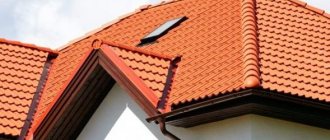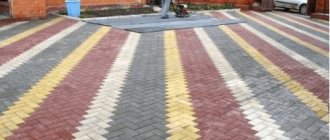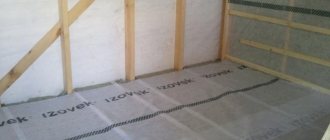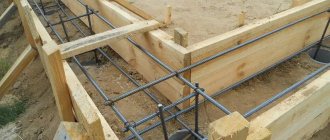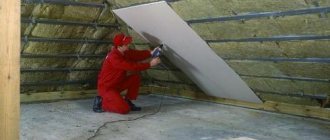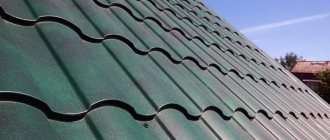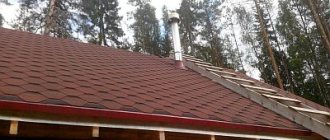Every day, environmentally friendly, strong and durable ceramic tiles are becoming more and more popular in Russia and other CIS countries. Until recently, such roofing was in demand only in Europe, and in our country there were often either metal or bituminous shingles, which rather ineptly imitated the real thing. What changed? Import to the market of foreign natural tiles, with improved geometry and stunning design!
A house with such a coating looks so advantageous against the background of surrounding buildings that today there are a lot of people who want to study the installation of ceramic tiles and make the roof of their new family nest real armor. And now we will reveal to you all the technical secrets!
Calculation and design of a tiled roof
The calculation of the roof begins with drawing up a drawing of the roof in plan. If necessary, draw drawings of all slopes separately (this is useful if the roof has a complex shape with many individual elements). The area of each section is calculated and the total area of the entire roof is found, from which the number of elements is calculated. You need to know the usable area of the tiles (cement-sand tiles are available in two sizes, but ceramic ones have more varieties).
Typically, for each type of material the number of elements per 1 m2 is indicated. This helps to calculate the amount of material, but this is only the number of basic, ordinary elements.
It is also necessary to calculate the total length of the ridge line, cornices, count the number of end sections of the ridge and other elements. These values are needed to determine the number of additional elements:
- skating
- lateral
- hip
- half
These elements are used to decorate the transition areas of planes (ridges and valleys), as well as to finish the eaves of the roof. When purchasing tiles, you need to make a reserve of 10-15% for ordinary material, and for additional materials, the reserve can be made less - 3-5%. Extras are expensive, their number can be calculated with sufficient accuracy, therefore, it is not advisable to make unnecessary expenses.
If independent calculation seems too complicated, it is better to use the services of professionals! Our construction bureau “Vayatel” performs turnkey roof installation: from design to a lifetime guarantee after installation. Certificates and our projects.
Tips and tricks
To build a beautiful and high-quality roof, you should listen to the advice of professionals:
- the weight of 1 m2 of ceramic tile covering must correspond to the load-bearing capacity of the roof in order to avoid its destruction from overload;
- the color of the ceramic tiles is selected so that the roof harmoniously combines with the facade and other buildings of the architectural ensemble;
- ceramic tiles are purchased after accurate calculations, allowing for a 10% margin for trimming and breaking;
- It is better to calculate additional elements with an experienced roofer.
Ceramic tiles made from fired clay are considered an eternal material. After careful dismantling of the old roof, the entire elements are suitable for reuse in small buildings. Old ceramic tiles can be used to cover a canopy, gazebo, or outbuilding.
Roofing pie composition
A roofing pie is a layer of thermal insulation packed in a cocoon of vapor barrier film and vapor barrier membrane. Layers are usually laid in the following order (in order of installation):
- steam-waterproofing membrane. Has one-way permeability, capable of releasing moisture from the inside, but not from the outside
- insulation
- vapor barrier film
Sometimes the roofing pie has a more complex structure, but the above option is the most common. It is noteworthy that this design is used only for mineral wool. Polystyrene foam or penoplex can be laid without steam-hydroprotection, since they are absolutely impermeable to water in any form (especially penoplex).
Stage II. Preparing clay
Clay for tiles must be constantly mixed and also filled with water.
Once a good clay has been selected, it can begin to be prepared for processing. Typically, clay is prepared for tiles at any time of the year, but it still needs to survive the winter.
So, the clay taken out of the ground needs to be piled on the ground surface in the form of ridges 2 m wide and 70 cm high. Such ridges are usually called stacks. This is how the clay will have to lie until it warms up - it will get wet from the rains in the fall, freeze in the winter, and thaw in the spring. After all this it will be much easier to process. And in order for the clay to freeze better, it is advisable to periodically stir the piles and even fill them with water. After all, the longer it is frozen, the better. Even if the clay lies like this for several years, it will only benefit it.
Rafter system
The design of the rafter system must be optimized for the installation of tiles at the design stage. To do this, you need to take into account the large weight of the roof and choose the correct section of rafter legs (from 50 × 200 mm). In addition, it is necessary to select a rafter installation step that corresponds to the size of the heat insulation slabs. This will speed up the installation of insulation and avoid loss of material during fitting.
The rafter system for laying tiles must be reinforced. As a rule, additional rafter legs are used or struts are installed (additional supports to support the central part of the rafters). This is especially important on roofs with long slopes and low slope angles.
Another important point is the accuracy of the planes . There should be no sagging or curvature - all flaws will affect the appearance of the roof and greatly complicate installation. Therefore, before starting to lay the vapor barrier membrane, it is necessary to check the rafter structure using a long straight batten and carefully correct all detected distortions.
Method for calculating the distance between rafters
The distance between the rafters on the roof is called the rafter pitch. As a rule, the pitch of the rafter legs in a roof structure usually exceeds one meter, and the minimum gap ranges between 60 centimeters.
Calculation of the required number of rafters for a roof of a certain length and the pitch of the rafters is carried out as follows:
- before calculating the length of the rafters, measure the length of the slope along the eaves of the roof;
- the resulting value is divided by the selected distance between the rafters. For example, the step is one meter, which means you need to divide by one, and if it is 60 centimeters, then the divisor will be equal to 0.6;
- then one is added to the result, and the result is rounded up.
Thus, through simple calculations, the number of rafters that need to be installed to construct one roof slope is determined. After this, the length of the slope is divided by the resulting number of rafters, resulting in the value of the interaxial gap between the rafters, called the pitch.
For example, with a roof slope length of 25.5 meters and a step length of 0.6 meters, the calculation is performed as follows:
25.5: 0.6 = 42.5 + 1= 43.5, after rounding to the nearest whole number the result will be 44 - this is the number of rafters required for the roof slope.
Next, to determine the distance between the axes of the rafters, you need 25.5: 44 = 0.58 (meters).
This simple technique, which allows you to determine at what distance the rafters for the roof are placed, does not take into account the characteristics of the roofing material used. There are professional recommendations regarding the pitch of the rafter system for the most popular coatings.
Installation of thermal insulation, vapor barrier and waterproofing
Installation of thermal insulation elements and protective sheets is carried out in the following order:
- hydro-vapor barrier membrane. This is a rolled material capable of transmitting water vapor in one direction. It is attached to the outside of the rafters, checking that the installation is correct - the canvas should allow steam to pass out, and not vice versa
- heat insulator Usually slab basalt mineral wool is used, as this is the cheapest and most effective option.
- vapor barrier film. This is an ordinary polyethylene sheet laid in horizontal stripes, starting from the bottom and overlapping. The joint lines are glued with tape, ensuring complete tightness of the canvas.
The membrane is installed externally, attaching strips of material parallel to the ridge (or eaves) line, starting from the top. The joints on both sides are taped with tape so that draining condensate cannot get into the cracks.
The heat insulator is installed from the inside, placing the slabs tightly between the rafter legs and fixing it with a perforated metal strip or polyurethane foam.
The vapor barrier is installed last, laying strips of polyethylene in rows starting from the bottom. The joints are overlapped and sealed with tape.
Ventilation and aero elements
Ventilation of the under-roof space is ensured by the ventilation gap between the tiles and the waterproof (diffusion) membrane. It is formed by strips attached to the rafters on top of the membrane sheet. The minimum gap thickness is 40 mm. Air moves freely in it, allowing condensation to evaporate and be discharged outside.
Natural tiles are considered a “breathable” roof. It is impossible to lay the elements so tightly as to form a completely sealed canvas. However, you should not count on self-ventilation of the roof - over time, all the small gaps between the individual elements will become clogged with dust and small debris. The permeability of the roof will be weakened, and it will become impossible to do without a ventilation gap.
Aeroelements are used for additional ventilation. These are special components that have holes for air to pass through the roof. They are designed in the form of protruding pipes or ordinary holes, covered with a protective cap.
When choosing the appropriate type, you should take into account the angle of inclination of the slopes and the amount of snow in winter - if there is a lot of it, it is better to install pipes. Their height is about 50 cm, which prevents a layer of snow from blocking the ventilation of the under-roof space.
Advantages and disadvantages
The first and undoubted advantage of this type of roofing material is its naturalness and environmental friendliness. After all, this is clay with some additives, fired in an oven at a very high temperature. That's all the technology and composition. But there are other advantages:
- Fire resistance and fire safety. This is very important in such a fire-hazardous facility as a bathhouse, where the temperature of the flue gases often exceeds 200-300°C and sparks often fly out.
Ceramic tiles can have different profiles - Long service life. For some types of ceramic tiles, manufacturers provide a guarantee of 50 years or even more. Some varieties can withstand up to 1000 cycles of freezing and thawing. The figure is simply amazing, so 50 years is clearly not the limit.
- Highly decorative. The roof looks very attractive and can be used for buildings of any style.
- Low thermal conductivity. The ceramic layer is an excellent heat insulator, which means less insulation is required. Due to the high thermal inertia, there are no sudden temperature changes in the under-roof space, and condensation rarely occurs on the inside of the tiles. These properties make tiled roofing the best when installing an attic floor.
- When it rains, falling drops do not produce any significant noise.
- Low hygroscopicity. Only 5-6% of the total mass is absorbed.
It was not for nothing that ancestors laid tiles on the roof. She has a lot of excellent qualities. But there are also disadvantages, and you need to know them:
- Heavy weight. This leads to the fact that the rafter system must be made of more powerful timber, and supports must be installed more often. In addition, the significant mass makes transportation more difficult. The mass of the tiles must also be taken into account when designing the foundation.
- Laying is possible only by hand, without the possibility of using machinery. Although new tile models have made the installation itself much easier.
- The slope should be steeper so that the water drains quickly.
- For painted tiles (by any method), the natural color is visible in places where they are chipped.
There aren't many downsides, but there are some. How significant they are, everyone decides for themselves.
Lathing and counter-lattice
Sheathing is a system of wooden planks to which shingles are attached. It is laid parallel to the line of the ridge (or eaves) with a step corresponding to the size of the roof elements.
The counter-lattice is bars attached to the rafters on top of the waterproofing membrane. They form the ventilation gap. The sheathing is attached to them in the transverse direction.
Particular attention should be paid to the installation of sheathing elements, since the possibility of installing the roof depends on their location. It is recommended that you already have tiles (or at least samples) at the time of installation so that you can check the correctness of the chosen sheathing pitch . This will avoid rework and corrections, which can be a very labor-intensive task on large rooftops.
In addition, we must remember that a thickened (sometimes continuous) sheathing is installed along the eaves and valleys. This is done to ensure high-quality design of cornices and valleys as the most important and loaded elements of the roof.
How to calculate the amount of material?
Installation of tiles, like any other material, begins with a preliminary calculation of all components. Therefore, first determine the surface area that needs to be covered, and also take measurements of the slopes. Due to the fact that tiles are available in different sizes, they can be easily matched to a design of simple or complex shapes.
Since the product is characterized by a large weight, before installation it is also important to calculate the strength of the frame and select the step of fastening the sheathing boards
To do this you need to measure:
- roof length;
- the pitch of the boards on the overhang (cannot exceed 390 mm);
- the distance from the outer board of the sheathing to the ridge (leaves 20-40 mm).
Gutter installation
Kapelnik
Installation of drainage elements is carried out before laying the roof. First, a drip is installed. This is a profile in the form of a corner with a wide vertical shelf. It is attached directly to the rafters even before installing the counter-lattice and placed along the eaves line. The drip tray is used to remove condensate from the diffusion membrane into the gutter.
Hooks
After installing the sheathing, hooks for the gutters are attached. The trays themselves can be installed later, the main thing is the supporting elements for them. The position of the hooks is chosen so that water from the outermost (lower) row of tiles flows directly into the gutter. As a rule, the overhang of the bottom row corresponds to 1/3 of the width of the drain.
Cornice strip
In addition, it is necessary to install a curtain rod. Different elements can be used here - a special metal profile or a perforated strip for free air access. The choice depends on local climatic conditions or the personal preferences of the owner.
Installation of gutters
The final stage is the installation of gutters. They are placed on supporting elements (hooks) and fixed in a regular manner. It is necessary to provide a slight slope towards vertical drains. It is necessary to take into account that each drain is capable of receiving water from a maximum of 150 square meters. m of roof.
You can increase the number of elements, but you cannot reduce them - the system will not cope with the load, and the water will begin to pour directly onto the ground. Puddles will appear, and drainage may penetrate into the basements.
Triangular and trapezoidal slopes
- When installing metal tiles on these types of slopes, additional counter-battens are installed along the ridges of the slopes.
- Further steps are similar to the installation of standard roofs. Then the cornice board, cornice strip, drain hooks and drip line are installed.
- The sheet of metal tile is cut along an oblique line so that the distance to the sheet of the next slope is 60-80 mm.
- Installation of ridge strips is also carried out from the bottom up.
It is important to ensure that the axis of the ridge strip runs clearly along the axis of the ridge. The junction of the two ridges and the ridge can be formed with a plastic Y-shaped tee.
How to lay ceramic tiles?
The technique for laying tiles depends on its type (locking, groove, flat, etc.). Before starting work, it is necessary to study the installation method for the existing material, acquire tools and devices for performing installation work.
Safety precautions
In addition, you must use personal protective equipment - a safety mounting belt. The work is carried out at heights; if you are careless, you can fall off the roof and suffer serious injuries.
Tools
You should also consider how to place your tools. Carrying a large bag or box with you is impossible, and making scaffolding or scaffolding of the required size is a difficult and time-consuming task. It is recommended to use cordless power tools and get a special work belt to which the main tools are attached - this way you can free your hands and always have the necessary accessories at hand.
To perform installation you will need:
- grinder with cutting disc for stone
- screwdriver with bit set
- tape measure and ruler
- building level
- thin twine for installing mooring lines
- rubber or plastic hammer
Only the most important tools are listed. Not all of them may be required, or there may be a need for additional devices - it all depends on the complexity of the roof, its configuration, and the presence of additional roofing elements.
Laying tiles on slopes
The tiles are laid in accordance with the design and location of the locking elements. As a rule, installation is carried out in horizontal rows in the direction from right to left. Laying begins from the cornice and gradually rises to the ridge.
If the tiles are of wave type, all elements are laid one above the other. On a flat roof, the elements alternate - in even rows the outer parts are whole parts, in odd rows - halves. This must be taken into account when purchasing material and immediately purchase the required number of half elements. Otherwise, you will have to waste time cutting during installation.
In order to organize the process with maximum productivity, all the material is lifted up at once and distributed in stacks (5-6 pieces) over the entire area of the roof (or section thereof).
This allows you to save time on delivery, not be distracted from the installation process and perform the work with the best quality. Tile is a fragile and rather heavy material, therefore, it is better to lift it in an organized manner, with the assistance of assistants and insurance against possible falls.
If you have no experience, you need to work slowly, constantly checking the instructions for laying tiles (as a rule, they come complete with the material). It is better to spend a little time on self-control than to redo all the work - it is much more difficult and takes more time.
Methods for fastening tiles
The method of fastening roofing elements depends on their type. There are different options:
- laying tiles with the element protruding from the inside resting on the sheathing
- fastening with self-tapping screws
- wire fixation
- conventional laying on the lathing with a hook on the lower protruding element
- combined installation methods
Fastening the material with screws is used on almost all types of tiles. However, not all elements are fastened with screws, but only the lower and upper rows. In addition, all cut parts are secured with screws.
The garter with a wire attached to a loop on the wrong side of the material serves as an additional element of fixation and is almost always duplicated with screws. This fastening is used when laying material on slopes with a small angle of inclination. In such conditions, a strong gust of wind can lift the tiles and destroy the roofing sheet. Additional fixation eliminates this possibility.
In addition, laying on “wet” mortars is sometimes used. This occurs rarely, only when laying tiles on a dense, rigid base.
Instructions for installing a roof made of natural tiles
The process of installing a tiled roof is divided into 2 stages.
The first stage includes calculating the need for materials and preparatory work.
At the second stage, all manipulations for installing the roofing pie are performed.
Ceramic tiles are laid with an overlap depending on the angle of inclination of the roof plane. Therefore, to calculate the required amount of material, it is necessary to know the area of the roof and its slope relative to the horizon.
NOTE!
If the roof slope is less than 16 degrees, the overlap will be 10 centimeters or more. With a slope of 16 to 30 degrees - 8-10 centimeters, and with a greater slope, an overlap of 7 centimeters will be sufficient.
Rafter system
The load created by ceramic tiles per 1 m2 of roofing is approximately 50 kilograms. Also, when making calculations, snow and wind loads should be taken into account. Therefore, in order to withstand such weight, the rafter system must have a sufficiently high load-bearing capacity.
The best solution for making a rafter system would be to use timber with a section of 75 by 150 millimeters.
It is recommended to choose the pitch of the rafter legs in the range from 60 to 90 centimeters.
Construction of the rafter system
Manufacturing of sheathing
To make the sheathing, it is necessary to use softwood bars with a cross-sectional size of 50x50 mm. and humidity not exceeding 25%. The number of sheathing guides should be equal to the number of tile rows, plus an additional row running along the eaves overhang.
It is necessary to pay attention to the fact that the width of the laths running along the eaves overhangs must be increased by 1.5 - 2 centimeters. This is necessary to level the roof surface
Sheathing device
Installation of thermal insulation, vapor barrier and waterproofing
Installation of a ceramic roof involves the installation of ventilation gaps to prevent moisture from penetrating into the roofing pie, wetting of the insulation and the formation of condensation.
- The first layer is a vapor barrier material. It is attached to the inside of the rafters with an overlap of at least 15-20 millimeters.
- Next, a layer of insulation is laid between the rafters. Insulation boards must be laid flat to prevent them from falling onto the vapor barrier layer.
- The last layer of waterproofing is installed. It is necessary to leave a ventilation gap between the insulation layer and the waterproofing. The film unfolds from the lower edge of the roof slope horizontally, along the eaves. The recommended overlap when installing a waterproofing layer is from 10 to 20 centimeters, depending on the angle of the slope.
CAREFULLY! It is important to remember that the waterproofing film should sag between adjacent sheathing elements by 1 - 2 centimeters. This is necessary so that condensation accumulates in the formed grooves and does not linger on the roof elements.
Roofing pie under tiles
Roofing pie under tiles
Installation of natural tiles: instructions
First of all, you need to check the roof for deviations from the plane of the slope. The deviation for each meter of surface should not exceed 2 - 3 millimeters. Next, you need to lift all the material onto the roof and evenly place it in stacks of several tiles on its surface. In the future, it is necessary to completely lay out rows of tiles along the eaves overhang and ridge. At the next stage, you need to mark the lines for installing the vertical columns
It is important to mark the gable line and additional lines every few rows of shingles.
Further installation begins from the lower right corner of the roof made of natural tiles, with gradual advancement to the left and upward. At the next stage, gable and ridge elements are installed. At the points of contact between the gable and ridge tiles, they need to be adjusted to each other by trimming.
The eaves overhangs are hemmed with boards to ensure air access to the ventilation ducts. To prevent installers from falling from the roof, it is advisable to use safety ropes.
Installation at joints
Fastening tiles
Installation of a ceramic roof is a rather complex and time-consuming process. It is advisable to entrust all of the above operations to a professional team of builders. This approach guarantees compliance with all the rules for installing natural roofing tiles, and therefore, the roof will delight the owners of the home for many years.
Endova
The valley is the line connecting two adjacent roof planes. It is the most loaded element. Runoff from two slopes flows here, and in winter snow accumulates here. In addition, leaves and small debris brought by the wind often accumulate in valleys.
Installation of the valley is carried out in two stages:
- gutter installation (done before laying the main roof)
- laying roofing with trimming along the valley line
First, a reinforced sheathing is made. It is attached to diagonal counter batten strips installed on adjacent slopes 10 centimeters from the line connecting the planes. After this, a continuous sheathing is laid at a distance of 30 cm from the line of intersection of the planes. This will help securely secure the gutter and prevent the roof elements from sagging under snow pressure in winter.
Laying the valley begins from the bottom. The gutter is assembled from individual elements, which are attached to the sheathing using screws. Sometimes, instead of ceramic parts, a metal gutter is used as part of the components for metal tiles. The installation process is almost the same, only you first need to bend the edges and bend the gutter according to the angle of connection of the roof slopes.
The procedure is completed by laying ordinary roofing elements on adjacent slopes. The outer parts are trimmed, forming straight lines along the edges of the valley gutter.
Valley waterproofing
The endova is an area where moisture drains from two adjacent slopes. This makes it particularly dependent on the quality and effectiveness of the waterproofing. Therefore, the valley section is equipped with a triple layer of diffusion membrane:
- a strip of material laid along the entire valley line
- the edge of the canvas from one slope laid on top of the first strip (with a transition through the valley to the second slope)
- edge of the canvas of the second slope (in the same way, only in mirror image)
This waterproofing makes it possible to eliminate the formation of leaks. In addition, if a blockage occurs in the valley, formed by the accumulation of debris and leaves, the risk of leakage of drains is reduced - they fall on the triple waterproofing and flow into the gutter.
The membrane is fastened to the rafters and counter-lattice strips using a stapler. You can also use wide headed nails (we recommend choosing aluminum or brass fasteners).
Trimming tiles for valley joints
Trimming the outermost elements of the tiles is done as the roof is laid on the slopes adjacent to the valley. For greater accuracy, two straight lines are drawn along the gutter line with chalk, along which the cutting line of each extreme element will be marked.
The recommended overlap of the trimmed elements on the valley gutter is 8-10 cm. Sometimes you have to use half elements if too large a piece needs to be cut off from whole ones.
In addition, many specialists perform pruning in 2 stages:
- rough trimming is performed and the element is tried on at the installation site
- make the necessary adjustments and trim the tiles clean
The tiles are cut using a grinder. Install a cutting wheel for the stone. It is not recommended to cut tiles directly on the roof; it is better to install a workbench in the attic. This will allow you to avoid going down to adjust each roof element.
What is a soft roof?
The category of soft roofs includes not only bituminous shingles, but also a number of other roofing materials - rolled overlay, membrane. But they are intended mainly for covering flat roofs, and flexible tiles are intended for pitched roofs, therefore they are more often used in private housing construction.
Soft roofing is a plastic roofing material in the form of shingles 1000 mm long and of different widths (from 317 to 349 mm). It is made on the basis of fiberglass impregnated with modified bitumen. The outer surface is decorated with stone pavement, which serves to protect against atmospheric influences and provide aesthetics due to a wide range of colors.
Photo 1. Appearance of shingles
Thanks to its flexibility, the installation of a soft roof can be carried out on roofs of the most complex configuration, up to domed, conical and even bulbous.
Figure 2. Types of complex roofs covered with a soft roof
The thickness depends on the type of coating:
- single layer – 3 mm;
- two-layer – 5.6-6 mm;
- three-layer – 9 mm.
Experts recommend constructing a roof from a multi-layer (laminated) soft roof. With an increase in the number of layers and thickness, the technical and operational parameters of flexible tiles also increase.
Photo 3. Appearance of a multilayer coating
When choosing, it is important to know that the minimum slope of a soft tile roof is 12°. If it is less, absolute tightness of the coating will not be achieved.
Bypasses and junctions
Bypasses of elements protruding from the roof, as well as areas where the roof abuts the walls are critical areas of the roof covering. This is where most leaks occur due to inept or sloppy installation.
To decorate these elements, special additional elements are used - aprons. They are part of the components for metal roofing, but also work quite effectively in conjunction with natural tiles.
In addition, a special tape for junctions is used for sealing. This is a strip of elastic material, the upper part of which is glued to the apron using its own adhesive layer. The lower part of the strip is profiled along the surface of the tile and glued to it, forming a dense and sealed transition unit.
Window bypass and waterproofing of junctions
Bypassing attic windows is a complex roofing element that is performed in two versions:
- two valleys and a ridge element without vertical walls
- vertical walls and two small slopes adjacent to the main roofing sheet
The first option is carried out in the standard way - the valleys are formed, the tiles are laid and trimmed accordingly. Sometimes, instead of valleys, a simpler transition method is used, when water flows from the window slopes onto the main roof without assembling the lower gutter.
The second design option requires the installation of junction units. On the vertical walls there is a groove into which the edge of the apron is inserted - a metal profile from the components for the metal roof. The apron itself is attached to the wall with screws.
Lay the tiles, adjusting the elements so that the gap between them and the vertical surfaces is no more than 20-25 mm. After this, it is covered with an elastic tape for the junctions. It is equipped with its own adhesive layer and attaches well to the metal element and to the tiles.
Connection to chimneys and ventilation
The design of the area adjacent to the chimney is done in the same way as to vertical walls. The only difference is the need to surround the chimney on all sides.
To do this, you need a complete set of accessories for bypassing chimneys, which comes complete with metal tiles:
- top apron
- bottom apron
- side aprons
These elements are cut to the width of the corresponding sides of the chimney and installed on it, having previously made a groove. Fireproof sealant is used to seal the top. When the procedure is completed, they begin laying the tiles, adjusting the adjacent elements in length and width (depending on their position in the row).
When a section of the canvas is laid around the entire chimney, an elastic tape is glued to the junctions.
Stage VII. Fixing tiles using different methods
Now let's talk about fastening the tiles. Up to 60 degrees, most of the tiles do not need to be fastened at all; only the bottom row on the overhang, the top ridge rows and the side gable rows must be fixed.
They also fasten all the trimmed tiles, which are usually located on the valley, ridges and adjacent to the walls, roof windows and hatches. In regions with strong winds, shards are additionally secured with wire.
But groove tiles, which are also called castle tiles, are produced separately. It has the largest area and profiled shape, and this tile differs from others in the presence of locks.
The locks consist of two edges, top and side, which overlap the adjacent ones, snap into place and ensure reliable tightness of the coating. In addition, at the bottom, such tiles have protrusions that, during installation, cling to the sheathing bars.
The most popular models of such tiles are double S-shaped, Dutch and S-shaped Marseilles. Most of them have sliding locks, so the shingle periods can be made as wide or as narrow as possible. Thanks to the presence of such sliding locks, the tiles fit perfectly into the existing spacing of the bars, and there is no need to trim them:
In addition, basically all tiles today are produced with two manufactured holes for screws. They are not end-to-end, it is worth noting.
Therefore, if you decide to fasten the tiles, then these holes need to be drilled with a 6 mm drill and fixed at the top to the sheathing using two anti-corrosion screws 4.5 by 50 mm, and at the bottom with anti-wind clamps.
Also, if the slope has a length of more than 4.5 m, additional ventilation tiles must be installed on it. This is placed in the third row, in increments of 1 meter. If the slope is more than 7 m, then the ventilation tiles are laid in two rows:
Ventilation tiles are also needed where chimneys or roof windows are located, because these create obstacles to the air circulation under cover.
Installation of ridge tiles
Ridge tiles are a set of elongated elements with a semicircular cross-section. They are installed overlapping and secured with screws.
To do this, you need to install a ridge bar, the height of which is determined experimentally - one element of the ridge tile is applied to the laid roof and the height of the bar is determined. It is necessary to ensure tight fastening, to prevent the occurrence of a large gap between the ridge elements and the roof.
At the same time, it is necessary to avoid the appearance of a gap between the top of the block and the top of the ridge element - when screwing in the screw, it may crack. The last tile (called the initial tile) is secured with screws and sealant.
Other jobs
Using special materials produced by Brass, additional work is also performed, such as:
- Arrangement of connections between the roof structure and walls and other elements located on the roof.
- Installation of attic roof fracture.
- Installation of snow retention elements and safety elements for movement on the roof.
- Installation of a passage hatch for access to the roof when laying flexible tiles.
- Installation of various attachments in the plane of the tiles. This is necessary for the output of ventilation elements and antennas.
- Installation of decorative elements to decorate the roof.
Additional roofing elements
Additional roofing elements are areas for ventilation, antennas and other communications. For this, there are special parts that are installed in a standard way in the right place.
Snow guards
As a rule, snow retainers are not used on tiles - the specific nature of the roof is such that snow does not melt off on its own. In addition, snow guards will have to be attached taking into account the height of the wave and the thickness of the material. This will cause the tiles to crack and break, which is unacceptable.
Rafter structure for ondulin
When creating a roof from ondulin, the pitch of the rafter system should be at least 600 millimeters, and the maximum distance between the rafters should be no more than 900 millimeters. For the rafter system, boards of 50x200 millimeters are selected and thereby provide an insignificant margin of safety, taking into account the rafter purlins.
On top of the counter-lattice and rafter structure, a lathing made of 40x50 millimeters of timber and an interaxial spacing of 60 centimeters is laid (read the article: “Ondulin or metal tiles - which is better”).
Coating care
Maintenance of tiles is minimal. The only necessary procedure is to remove debris and fallen leaves from the valleys. In addition, you can periodically water the roof with water from a hose, washing away dust and sand brought by the wind.
When the roof becomes old enough, moss may appear. This is an undesirable phenomenon that should be dealt with. Moss is removed from the roof surface on your own or with the assistance of specialists. You can apply a protective impregnation (hydrophobicize the roof) to prevent the re-growth of moss.
Additional materials on the topic
Reviews about ceramic tiles
More details
Roofing units made of ceramic tiles
More details
Ceramic tiles koramic
More details
Your feedback, comments, questions
Dear visitors! We will periodically answer your questions in the comments as we are busy. In order for us to respond to you promptly (within an hour), you can: call, write a personal message or leave a request for a free consultation by phone.

